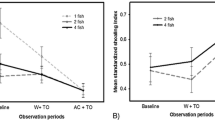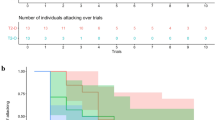Abstract
Reintroduction programs for conservation purposes suffer from low post-release survival of captive-bred animals, especially so with fish reintroductions. High mortality is most often due to weakened antipredator skills, which could be enhanced through direct experience with predators and social learning. As yet, the relative efficiency of these learning methods has not been tested, and the significance of the factors determining how efficiently antipredator responses are transmitted socially from experienced (“demonstrator”) to predator naive (“observer”) individuals is largely unknown. Using hatchery-bred stock of the endangered Saimaa Arctic charr (Salvelinus alpinus), we show for the first time that: (1) contrary to theoretical predictions, acquired predator recognition was only socially transmitted from predator-experienced to predator-naive fish in groups with a smaller proportion of experienced than naive individuals, and that (2) socially acquired avoidance of the predator odors was as strong as in those fish conditioned with a combination of odors and predator exposure. We conclude that using social transmission procedures in training fish for reintroduction programs may provide considerable ecological, economical and ethical advantages.

Similar content being viewed by others
References
Beck BB (1994) Reintroduction of captive-born animals. In: Olney PJS, Mace GM, Feistner ATC (eds) Creative conservation: interactive management of wild and captive animals. Chapman and Hall, London, pp 265–286
Brown C, Day R (2002) The future of stock enhancements: bridging the gap between hatchery practice and conservation biology. Fish Fisheries 3:79–94
Brown C, Laland KN (2001) Social learning and life skills training for hatchery reared fish. J Fish Biol 59:471–493
Brown C, Laland KN (2002) Social learning of a novel avoidance task in the guppy, P. reticulata: conformity and social release. Anim Behav 64:41–47
Brown C, Laland KN (2003) Social learning in fishes: A review. Fish Fisheries 4:280–288
Brown C, Warburton K (1999) Social mechanisms enhance escape responses in shoals of rainbowfish, (Melanotaenia Duboulayi). Environ Biol Fish 56:455–459
Brown GE (2003) Learning about danger: chemical alarm cues and local risk assessment in prey fishes. Fish Fisheries 4:227–234
Brown GE, Godin J-GJ (1997) Anti-predator responses to conspecific and heterospecific skin extracts by threespine sticklebacks: alarm pheromones revisited. Behavior 134:1123–1134
Brown GE, Smith RJF (1998) Acquired predator recognition in juvenile rainbow trout (Oncorhynchus mykiss): conditioning hatchery-reared fish to recognize chemical cues of a predator. Can J Fish Aquat Sci 55:611–617
Bshary R, Wickler W, Fricke H (2002) Fish cognition: a primate’s eye view. Anim Cogn 5:1–13
Chivers DP, Smith RJF (1995) Free-living fathead minnows rapidly learn to recognize pike as predators. J Fish Biol 46:949–954
Chivers DP, Smith RJF (1998) Chemical alarm signaling in aquatic predator-prey systems: a review and prospectus. Ecoscience 5:338–352
Day R, MacDonald T, Brown C, Laland K, Reader SM (2001) Interactions between shoal size and conformity in guppy social learning. Anim Behav 62:917–925
Fernö A, Järvi T (1998) Domestication genetically alters the anti-predator behavior of anadromous brown trout (Salmo trutta)—a dummy predator experiment. Nord J Freshwater Res 74:95–100
FitzGerald GJ, Havre N (1985) Flight, fright and shoaling in sticklebacks (Gasterostedae). Biol Behav 10:321-331
Giraldeau LA (1997) The ecology of information use. In: Krebs JR, Davies NB (eds) Behavioral ecology: an evolutionary approach. Oxford University Press, Oxford, pp 42–68
Giraldeau LA, Templeton JJ (1991) Food scrounging and diffusion of foraging skills in pigeons, Columba livia—the importance of tutor and observer rewards. Ethology 89:63–72
Giraldeau LA, Caraco T, Valone TJ (1994) Social foraging: individual learning and cultural transmission of innovations. Behav Ecol 5:35–43
Godin J-GJ (1986) Antipredator function of shoaling in teleost fishes: a selective review. Nat Can 113:241–250
Griffin AS (2004) Social learning about predators: A review and prospectus. Learn Behav 32:131–140
Griffin AS, Blumstein DT, Evans CS (2000) Training captive-bred or translocated animals to avoid predators. Conserv Biol 14(5):1317–1326
Heyes CM, Galef B G (1996) Social learning in animals: the roots of culture. Academic, London
Hirvonen H, Ranta E, Piironen J, Laurila A, Peuhkuri N (2000) Behavioral responses of naïve Arctic charr to chemical cues from salmonid and non-salmonid fish. Oikos 88:191–199
Howell BR (1994) Fitness of hatchery-reared fish for survival in the sea. Aquacult Fish Manage 25:3–17
Huntingford FA (1984) Some ethical issues raised by the studies of predation and aggression. Anim Behav 32:210–215
Johnsson JI, Abrahams MV (1991) Interbreeding with domestic strain increases foraging under threat of predation in juvenile steelhead trout: an experimental study. Can J Fish Aquat Sci 48:243–247
Johnsson JI, Petersson E, Jönsson E, Bjönsson BT, Järvi T (1996) Domestication and growth hormone alter antipredator behavior and growth patterns in juvenile brown trout, Salmo trutta. Can J Fish Aquat Sci 53:1546–1554
Kelley JL, Magurran AE (2003) Learned predator recognition and antipredator responses in fishes. Fish Fisheries 4:216–226
Kelley JL, Evans JP, Ramnarine IW, Magurran AE (2003) Back to school: can antipredator behavior in guppies be enhanced through social learning? Anim Behav 65:655–662
Kieffer JD, Colgan PW (1992) The role of learning in fish behaviour. Rev Fish Biol Fish 2:125–143
Klemetsen A, Amundsen P-A, Dempson JB, Jonsson B, Jonsson N, O’Connell MF, Mortensen E (2003) Atlantic salmon Salmo salar L., brown trout Salmo trutta L. and Arctic charr Salvelinus alpinus (L.): a review of aspects of their life histories. Ecol Freshwater Fish 12:1–59
Kolari I, Hirvonen E, Friman T (1999) Nieriäistutusten tuloksellisuus Puruvedessä. Finnish Game and Fisheries Research Institute, Kalantutkimuksia 163
Krause J (1993) Transmission of fright reaction between different species of fish. Behavior 127:37–48
Krause J, Ruxton GD (2003) The benefits of group formation. In: Krause J, Ruxton GD (eds) Living in groups. Oxford University Press, Oxford, pp 6–40
Kroon FJ, Housefield GP (2003) A fluviarium with controlled water quality for preference-avoidance experiments with fish and invertebrates. Limnol Oceanogr Methods 1:39–44
Lachlan RF, Crooks L, Laland KN (1998) Who follows whom? Shoaling preferences and social learning of foraging information in guppies. Anim Behav 56:181–190
Laland KN, Williams K (1997) Shoaling generates social learning of foraging information in guppies. Anim Behav 53:1161–1169
Lefebvre L, Giraldeau LA (1994) Cultural transmission in pigeons is affected by the number of tutors and bystanders present. Anim Behav 47:331–337
Magurran AE (1990) The adaptive significance of schooling as an anti-predator defence in fish. Ann Zool Fenn 27:51–66
Magurran AE, Higham A (1988) Information transfer across fish shoals under predation threat. Ethology 78:153–158
Makkonen J, Piironen J, Pursiainen M (1997) Saimaan nieriän emokalasto ja istutukset. In: Makkonen J (ed) Saimaan nieriä, syvien vesien uhanalainen. Finnish Game and Fisheries Research Institute, Kalantutkimuksia 133, pp 11–43
Mathis A, Chivers DP, Smith RJF (1996) Cultural transmission of predator recognition in fishes: intraspecific and interspecific learning. Anim Behav 51:185–201
Metcalfe NB (1990) Aquaculture. In: Monaghan P, Wood-Gush DGM (eds) Managing the behavior of animals. Chapman and Hall, London, pp 125–154
Mirza RS, Chivers DP (2000) Predator recognition training enhances survival of brook trout: evidence from laboratory and field-enclosure studies. Can J Zool 78:2198–2208
Mirza RS, Chivers DP (2002) Behavioral responses to conspecific disturbance chemicals enhance survival of juvenile brook charr, Salvelinus fontinalis, during encounters with predators. Behavior 139:1099–1109
Olla BL, Davis MW (1989) The role of learning and stress in predator avoidance of hatchery-reared coho salmon juveniles. Aquaculture 76:209–214
Olla BL, Davis MW, Ryer CH (1994) Behavioural deficits in hatchery-reared fish: potential effects on survival following release. Aquacult Fish Manage 25 [Suppl 1]:19–34
Olla BL, Davis MW, Ryer CH (1998) Understanding how hatchery environment represses or promotes the development of behavioral survival skills. Bull Mar Sci 62:531–550
Pfeiffer W (1962) The fright reaction of fish. Biol Rev 37:495–511
Piironen J (2003) Saimaan rasvaevällisten tulevaisuus ja käytännön hoitotoimet. In: Leskelä A (ed) Kalavesien hoidon uudet tuulet; Kalantutkimuspäivät 2003. Finnish Game and Fisheries Research Institute, Helsinki. Kala-ja riistaraportteja 291, pp 15–19
Pitcher TJ, Parrish JK (1993) Functions of shoaling behavior in teleosts. In: Pitcher TJ (ed) Behavior of teleost fishes. Chapman and Hall, London, pp 363–440
Pitcher TJ, Magurran AE, Winfield IJ (1982) Fish in larger shoals find food faster. Behav Ecol Sociobiol 10:149–151
Rassi P, Alanen A, Kanerva T, Mannerkoski I (eds) (2001) Suomen lajien uhanalaisuus 2000. Ympäristöministeriö and Suomen ympäristökeskus, Helsinki
Reebs SG (2000) Can a minority of informed leaders determine the foraging movements of a fish shoal? Anim Behav 59:403–409
Rehnberg BG, Schreck CB (1987) Chemosensory detection of predators by coho salmon: behavioral reaction and the physiological stress response. Can J Zool 65:481–485
Shettleworth SJ (2001) Animal cognition and animal behavior. Anim Behav 61:277–286
Shively RS, Poe TP, Sauter ST (1996) Feeding response by northern squawfish to a hatchery release of juvenile salmonids in the Clearwater River, Idaho. Trans Am Fish Soc 125:230–236
Shumway CA (1999) A neglected science: applying behavior to aquatic conservation. Environ Biol Fish 55:183–201
Siegel S, Castellan NJ-Jr (1988) Non-parametric statistics for the behavioral sciences. McGraw-Hill, New York
Soria M, Gerlotto F, Freon P (1993) Study of learning capabilities of tropic clupeoids using an artificial stimulus. ICES Mar Sci Symp 196:17–20
Suboski MD (1988) Acquisition and social communication of stimulus recognition by fish. Behav Process 16:213–244
Suboski MD (1990) Releaser-induced recognition learning. Psychol Rev 97:271–284
Suboski MD, Templeton JJ (1989) Life skills training for hatchery fish: social learning and survival. Fish Res 7:343–352
Suboski MD, Bain S, Carty AE, McQuoid LM, Seelen MI, Seifert M (1990) Alarm reaction in acquisition and social transmission of simulated predator recognition by zebra danio fish. J Comp Psychol 104:101–112
Sugita Y (1980) Imitative choice behavior in guppies. Jpn Psychol Res 22:7–12
Sutherland WJ (1998) The importance of behavioral studies in conservation biology. Anim Behav 56:801–809
Vilhunen S, Hirvonen H (2003) Innate antipredator responses of Arctic charr (Salvelinus alpinus) depend on predator species and their diet. Behav Ecol Sociobiol 55:1–10
Wallace MP (2000) Retaining natural behavior in captivity for re-introduction programmes. In: Gosling LM, Sutherland WJ (eds) Behavior and conservation. Cambridge University Press, Cambridge, pp 300–314
Wiley RW, Whaley RA, Satake JB, Fowden M (1993) An evaluation of the potential for training trout in hatcheries to increase poststocking survival in streams. N Am J Fish Manage 13:171–177
Zar JH (1996) Biostatistical analysis. Prentice-Hall, Upper Saddle River
Acknowledgements
We thank M. Moilanen and M. Koskinen for assisting in the observations, C. Brown and M. Fowler for the comments on an earlier draft, and Saimaa Fisheries Research and Aquaculture for excellent facilities. We thank the Finnish Ministry of Education, Oskar Öflund-Foundation (to S.V.), Nordic Council of Ministers, and the University of Helsinki Research Funds for funding.
Author information
Authors and Affiliations
Corresponding author
Additional information
Communicated by J. Krause
Rights and permissions
About this article
Cite this article
Vilhunen, S., Hirvonen, H. & Laakkonen, M.VM. Less is more: social learning of predator recognition requires a low demonstrator to observer ratio in Arctic charr (Salvelinus alpinus). Behav Ecol Sociobiol 57, 275–282 (2005). https://doi.org/10.1007/s00265-004-0846-x
Received:
Revised:
Accepted:
Published:
Issue Date:
DOI: https://doi.org/10.1007/s00265-004-0846-x




